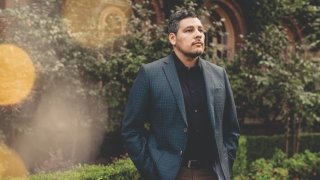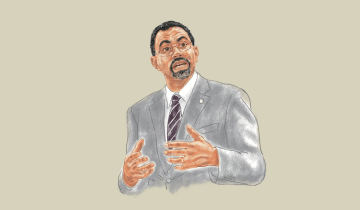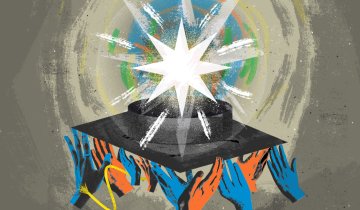Stephen Aguilar has been a classroom teacher, a developer of educational technology and a college professor. But now, he’s embarking on a new research project—one that could shape the way that artificial intelligence is understood and used in classrooms.
Earlier this year, with $10 million in seed money, USC announced the launch of the Center for Generative AI and Society to explore the transformative impact of AI on culture, education, media and society. Faculty and leaders from the USC Annenberg School for Communication and Journalism, the USC School of Cinematic Arts, the USC Jimmy Iovine and Andre Young Academy, the USC Viterbi School of Engineering and USC Rossier will explore the benefits and challenges of generative AI from a variety of angles. Aguilar, a USC Rossier assistant professor of education, is leading a project focusing on the application and innovation of AI in education—studying how, when and why students and instructors use AI to support their learning and instruction. Gale Sinatra, professor of psychology and the Stephen H. Crocker Professor of Education at USC Rossier, is serving as the project’s co-lead. Eventually, Aguilar would like to see students gain experience using AI tools—not as shortcuts or as plagiarism tools or as cheating aids, but as applications that they will likely use in future jobs. “I want them to feel prepared to navigate this new landscape that’s emerging,” he says.
The potential of using artificial intelligence in education settings has been a hot topic this year; some have foretold the end of the term paper as we know it, or the end of teachers. What’s emerged in the community are two major approaches, says Bill Swartout, a computer science research professor at USC Viterbi and chief technology officer for USC Viterbi’s Institute for Creative Technologies (ICT), who will co-direct the new center.
One is to try to discourage students from using ChatGPT and similar tools. The other focuses on adapting to the new reality that generative AI will be around for a long time, with classrooms needing to adapt an approach to education. “The folks at Rossier and we here at the ICT and in the center are very much in the latter category,” says Swartout. Education must adapt—and taking a stance that prevents people from using AI is doing students a disservice. This fall, the center will produce the first of a series of reports to assess how students are using the tech and how it might be best used in the future—something that’s important to know before demonizing the tool, Swartout says. “You’re teaching the ones who follow the rules to have no experience with ChatGPT until they get out of school and into a world where it’s pervasive, and you want to prepare them for it,” he says.
WHO’S USING IT, AND HOW?
Aguilar’s research aims to see how students are making sense of these new technologies: Are students using them as aides or shortcuts? As researchers start to have a better understanding of what students are doing, Aguilar’s goal is to examine the impact of generative AI technologies on student learning achievement—specifically, student engagement and motivation, he explains. An AI tool could be like a digital study partner, helping students make sense of a problem— or it could simply solve the problem for them. “How will students persist through tough problems in the age of AI?” he asks. “My emerging research is going to examine that question, among others.” The way that students incorporate generative AI tools into their study habits is the next frontier of research in educational technology, Aguilar notes.
In general, everybody is freaking out about AI and education, says Sinatra, “and I think the freakout is probably a little premature.”
“There are folks who say things have changed forever every time there’s a new technology. But the reality is that the fundamental process of engaging in the world and learning about it hasn’t changed.”
—Stephen Aguilar, assistant professor of education
Every time a new technology is introduced, Sinatra says, people say it’s either going to revolutionize or mean that teachers are done. “There’s always an extreme reaction, like we’re going to be taught by robots,” she says. But the reality Sinatra predicts is that generative AI will be a tool, like other existing technologies, that both students and teachers can use in their classrooms. How that tool will be used is very much up for grabs right now. “I think people need to step back and give it a little bit of time,” she says.
Many people have pointed out that ChatGPT can easily produce essays to help students cheat—and get good grades. But Sinatra says that if a teacher or professor is assigning a five-paragraph essay on a simple topic like the causes of the Civil War, that’s not a great assignment anyway. “I think that assignments need to be creative, individualistic [and] applied to a current context where students have to use their own thoughts and ideas,” she says. “ChatGPT can augment that.”
The technology is still unreliable in some contexts—it’s not 100% accurate in history or science, and it isn’t useful as a fact-checker yet, either. Sinatra has written about how ChatGPT could foster science denial, and she urges users to exercise caution and vet the information the application produces. Generative AI uses predictive language models and generates information based on what is likely to come next by analyzing large corpuses of language data. It works in a different way from an internet search—and ChatGPT isn’t always great at finding information, Sinatra says. There are many places where it could be useful—the first draft of an essay or providing explanatory text, for example.
“Maybe you want a summary of the IPCC report, so you ask ChatGPT to do a brief summary and you can check it,” Sinatra says. “It could save you 45 minutes or an hour of writing time. That’s the kind of thing: getting rough draft info out of it, which you can then edit for accuracy, for flow and to fit your needs.”
AUTHORSHIP BY EDITING AND REVISING
Aguilar’s research will begin with surveys—asking students what they are using and why they are using it—but he also is developing tools that work alongside ChatGPT to begin to capture how students are actually using the technology. Working somewhat like plugins, the tools he and ICT are developing will be designed to better understand how students edit AI-generated text.

This idea of “authorship by editing and revising” acknowledges that writing changes when using generative AI. Tools like ChatGPT can write the first draft, allowing the student to move beyond the blank page and edit AI-generated text. “The idea of what writing means may shift internally for students and externally in terms of how we think of writing,” Aguilar says, “and we don’t quite know yet but our hunch is that this will likely become a new normal for some types of authoring.” If this is truly the new normal, Aguilar notes, then we should be preparing our students for engaging with generative AI rather than discouraging them from using it.
In one of the first research projects, after students receive instruction on different ways they can use ChatGPT, they will utilize the tool during their writing process and will revise and improve the machine-generated text, says Changzhao Wang, a postdoctoral researcher working with Aguilar at the center. “What we will do is investigate how students can benefit from different approaches to using ChatGPT and also offer great examples of how to do this well,” she says. This research, Wang explains, is designed to focus on the process of student learning when they follow the team’s instructions.
The reaction from teachers and professors has been mixed so far—Aguilar says he’s heard from faculty members who are very concerned with cheating and plagiarism, and also wonder about bigger issues, like the future of writing programs or on-campus writing centers. Others are optimistic: ChatGPT could potentially teach coding and programming much more easily. But it also leads to new questions for instructors to consider when they are evaluating code: Who is really being evaluated? Does it matter if the student didn’t write 100% of the code if they still understand how it works?
“That’s what we want to explore in the center: How are humans using this, how should humans use it and how should they not. The center is aiming to focus more on that human interaction.”
—Gale Sinatra, Stephen H. Crocker Professor of Education
None of this means that teaching and learning is fundamentally changing, says Aguilar. As far back as people
have records, new technologies have been feared. For example, Aguilar explains, Socrates is famous for stating that he hated the idea of writing because he feared it would lead to forgetfulness. In the 1500s, a Swiss scholar named Conrad Gessner spent his career writing the first bibliography and going around Europe to different libraries. He wrote that there were too many books, and something needed to be done about it—someone needed to separate the good books from the bad ones. (At the time, there were only about 3,000 books total in the continent’s collective libraries.) “There are folks who say things have changed forever every time there’s a new technology,” says Aguilar. “But the reality is that the fundamental process of engaging in the world and learning about it hasn’t changed.” He points out that nothing about this technology is changing working memory, or the way we process information.
Swartout uses the example of calculators: When graphing calculators became powerful three decades ago, some people bemoaned the situation and believed students would rely only on calculators and not learn the fundamentals that made them work. Instead, he points out, schools didn’t ban calculators but focused kids in the lower grades on learning arithmetic tables. Then, as the students got older and more advanced, the use of calculators was allowed and encouraged. “Sometimes [calculators are] even required at the higher grade levels. It frees you from the mundane minutiae of working out the arithmetic and allows students to focus on higher-level concepts,” says Swartout. “I’ve had conversations with faculty members in the English Department here at USC, and they’ve said: Anything that can get us off a student having to stare at a blank page, and get into the mode of thinking critically about what’s being written and whether it’s effective or not, is a win.”

FUTURE BENEFITS OF AI
In the future, generative AI may improve workflows and reduce the amount of time workers spend on rote or time-consuming tasks. Some classroom teachers are already using it to design skeletons of lesson plans and create prompts for students to respond to—things that would normally take teachers a long time to do either by hand or via traditional internet searches. Instead, teachers can now generate content immediately and then edit the output. “It reduces that lag between an idea and an artifact that helps instruction,” Aguilar says.
Another potential use for generative AI in education is personalization. For years, Aguilar says, educational technologies have promised to create learning experiences that adapt to students’ specific needs. Generative AI can help educators get closer to that goal by tailoring curriculum to individual students’ interests and needs, as well as capturing where some students might need extra instruction, thus actually creating personalized learning paths for them.
The technology can also break down barriers and make learning more accessible to more people—particularly in coding, Aguilar says. Imagine a tool that can be a conversation partner as well as a coach to help a student gain a new skill. And, finally, generative AI can be a potent research tool to help teachers and others parse large data sets to help uncover insights and patterns that might have gone unnoticed otherwise.
Universities are good at developing insights into the implications of innovation on instruction and student engagement, and setting guidelines for things that we should try to do better—or things to avoid, Aguilar says.“Our main contribution and approach is to be in the room when a lot of things are being designed so that we ensure that approaches are empirically sound,” he says.
“What we are doing differently is looking less at the tech itself but more at the human uses of the technology,” adds Sinatra. “That’s what we want to explore in the center: How are humans using this, how should humans use it and how should they not. The center is aiming to focus more on that human interaction.”






